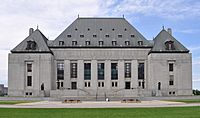R v Saskatchewan Wheat Pool facts for kids
Quick facts for kids R v Saskatchewan Wheat Pool |
|
|---|---|

|
|
| Hearing: February 17, 1982 Judgment: February 8, 1983 |
|
| Full case name | Her Majesty The Queen in the Right of Canada v Saskatchewan Wheat Pool |
| Citations | [1983] 1 S.C.R. 205 |
| Ruling | The Board's appeal was dismissed. |
| Court membership | |
| Chief Justice: Bora Laskin Puisne Justices: Roland Ritchie, Brian Dickson, Jean Beetz, Willard Estey, William McIntyre, Julien Chouinard, Antonio Lamer, Bertha Wilson |
|
| Reasons given | |
| Unanimous reasons by | Dickson J. |
| Laskin C.J. and Wilson J. took no part in the consideration or decision of the case. | |
R v Saskatchewan Wheat Pool is a very important case from the Supreme Court of Canada. It helps us understand a part of law called tort law. Tort law deals with situations where someone's actions cause harm to another person. It's about who is responsible for that harm.
In this case, the Court decided something key about "breach of statutory duty." This means breaking a rule that is written in a law. The Court said that just because someone breaks a law, it doesn't automatically mean you can sue them for damages. Instead, breaking a law can be used as proof in another type of lawsuit, like a case about negligence.
Contents
What Was This Case About?
This case was about a shipment of wheat and a rule that was broken. It helped to clarify how laws and lawsuits work together in Canada.
The Story Behind the Case
The Saskatchewan Wheat Pool is a company that handles grain. They sent a shipment of wheat from one of their storage buildings. This wheat was infested, meaning it had pests in it. This was against a rule in the Canada Grain Act, specifically section 86(c).
The wheat was going to the Canadian Wheat Board. The Board wanted to get money back because the rule was broken. They felt they had been harmed by receiving the bad wheat.
What the Courts Decided
First, the case went to the Federal Court of Canada. This court decided that the Canadian Wheat Board was right. They said the Board should get money for the rule being broken.
But the Saskatchewan Wheat Pool disagreed. They took the case to a higher court, the Federal Court of Appeal. This court changed the first decision. They said the Board should not get money.
So, the big question went to the highest court in Canada: the Supreme Court. The Supreme Court had to decide if breaking the Canada Grain Act automatically gave the Canadian Wheat Board the right to sue. This is called a "private right of action."
The Supreme Court's Decision
Justice Dickson wrote the decision for the Supreme Court. All the judges agreed with him. The Court decided that the Canadian Wheat Board could not automatically sue just because the law was broken. There was no "private right of action" in this situation.
Justice Dickson looked at how other countries, like England and the United States, handled similar situations. He concluded that if someone breaks a law and causes harm, it should be handled under the law of negligence. Negligence is when someone acts carelessly and causes harm to another.
The Court said that breaking a law can be used as proof that someone was negligent. It can also show what the expected "standard of care" was. The "standard of care" is how a reasonable person would act in a similar situation. So, breaking a rule in a law can show that someone did not meet that standard.

